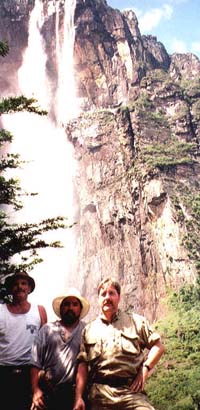 The Angel Falls Safari
The Angel Falls Safari
or Paintball for the fun of it
by Todd Inman
Excerpts appearing in Action Pursuit Magazine,
April 2000
reprinted by permission
(click on "thumbnail" images to see the pictures)
The old days
In the old National Survival Game days in the early '80s, paintball was
played with 15 man teams on 20+ acre fields in games lasting an hour and a half.
While there were some referees, play was necessarily on the honor system because
no one could possibly afford sufficient referee crews to police such a large
area and so many players. After the demise of the National Survival Game
circuit, and, for that matter, before its demise by some of the more adventurous
sorts, impromptu events were being invented around the country. "Challenge
matches", "travel events", and impromptu "monster
games" where the order of the day to satisfy players' growing thirst for
this exciting new sport. Examples of this in my own backyard included, for
instance, the yearly Virginia vs. Maryland "monster games" which ran
almost a decade, and challenge matches between the Green Machine of Virginia,
the Black Sheep of Florida, team Gangreen of New Hampshire, and others. The
monster games typically pitted 100 vs. 100 on 200 plus acre fields and
represented the honor of the state for the year. Prizes included the famous
one-of-a-kind victory T-shirt, a trophy, and a huge party at the end replete
with barbecue and all the beer you can drink. The challenge matches typically
consisted of one team traveling to the other's state for a weekend of
head-to-head competition for bragging rights, massive partying, and often a
small monetary wager.
Some of us never grew out of it
During the rest of the '80s after NSG's demise but before the advent of
"serious-minded" competitions the likes of NPPL and others, we
paintball aficionados had to make up events to entertain ourselves. The Green
Machine in particular made something of a career of road trips and has racked up
tours to every continent on the planet excepting Antarctica and Asia. The point
of these events has been to:
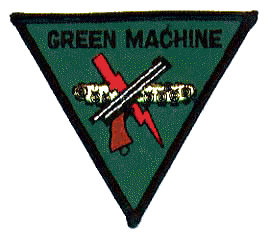
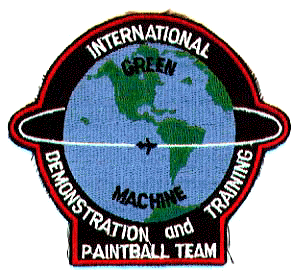
|
1. promote the good image and international acceptance of our sport;
2. assist nascent paintball organizations overseas in getting started;
3. promote the good name and products of the events' sponsors;
4. play competitive but fair and honest paintball;
5. have ourselves a rip-snorting good time.
|
To date we have conducted travel events to Canada, South Africa, Hawaii,
Australia, France, Russia, Brazil, and most recently Venezuela. As always, we
couldn't possibly go to all the trouble of traveling to these distant
destinations without spending some extra time savoring the host country's finer
points. You can read about these exploits in good ol' Action
Pursuit Magazine, our web site at
GreenMachinePaintball.com,
as well as in other publications and media over the years. To charges that we
still a have not grown out of this "phase", we must plead guilty. As
it turns out, we are not alone in craving the pure enjoyment of the sport
without all the hype and pressure.
The Flying Pigs
A few years ago some of us "old hands", having no other team
commitments at the moment, formed ourselves together as a "just for
fun" team and showed up at Deborah and Ryan's Pittsburgh Amateur Open as
the "Flying Pigs". Our team emblem included the Latin "Vinceremus
tum..." ("we will be victorious when...") underneath a logo of a
pig with wings, and our manifesto read:
|
To run, but not too hard.
To shoot, but not too fast.
To boldly go where your opponent has recently been before.
Above all, to play fair, shoot straight, and have a good time! |
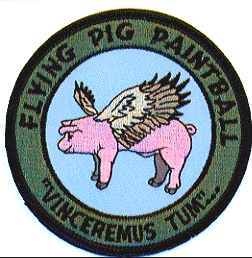
|
We were determined not to take ourselves to seriously and were the only squad
at the event that could boast a beer sponsor (to be consumed after the
day's play of course). This "industry team" roster consists of such
notables as Tim Schloss (Pursuit Products), Rose Smith (Unique Sporting),
Jessica Sparks (APG, everywhere), Dan Reeves (APG), Bud Orr (Worr Game
Products), Glenn Palmer (Palmer's Pursuit),
This "industry team" roster consists of such
notables as Tim Schloss (Pursuit Products), Rose Smith (Unique Sporting),
Jessica Sparks (APG, everywhere), Dan Reeves (APG), Bud Orr (Worr Game
Products), Glenn Palmer (Palmer's Pursuit), Don deKieffer (NPPL counsel, APG),
Jim Lively (Lively Productions), Sam Caldwell (Lively Productions), Randy Baxter
(Splat 1 Paintball), Dave Rudig (Paintball Dave's), Hansel Hertwig (Eastbank
Textiles), Mike Edwards (Paintball Enterprises), George Wilson (Paintball
Enterprises), Jaime Martinez (APG, Green Machine), Dale Bright (APG), Rene
Boucher (Paintball News), Dennis Ashley, and me.
Don deKieffer (NPPL counsel, APG),
Jim Lively (Lively Productions), Sam Caldwell (Lively Productions), Randy Baxter
(Splat 1 Paintball), Dave Rudig (Paintball Dave's), Hansel Hertwig (Eastbank
Textiles), Mike Edwards (Paintball Enterprises), George Wilson (Paintball
Enterprises), Jaime Martinez (APG, Green Machine), Dale Bright (APG), Rene
Boucher (Paintball News), Dennis Ashley, and me. 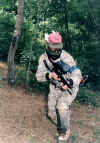 With this particular crew, even
with a roster of 15 to 20, fielding 10 at any one given time is always a
challenge - we even walked on the field at last year's Zap Masters with 9 in one
game!
With this particular crew, even
with a roster of 15 to 20, fielding 10 at any one given time is always a
challenge - we even walked on the field at last year's Zap Masters with 9 in one
game!
 To date the "Pigs" have made appearances at the last 3 Zap Amateur
Open events, and last year's Zap Masters. While we certainly haven't won all of
our games, we haven't lost all of them either, and we have one hell of a good
time in the process. Several of the "Pigs" periodically cross
pollinate with the "Machine" traveling team as was the case once again
on our recent trip to Venezuela.
To date the "Pigs" have made appearances at the last 3 Zap Amateur
Open events, and last year's Zap Masters. While we certainly haven't won all of
our games, we haven't lost all of them either, and we have one hell of a good
time in the process. Several of the "Pigs" periodically cross
pollinate with the "Machine" traveling team as was the case once again
on our recent trip to Venezuela.
The Venezuela trip
It was time once again for the Green Machine to venture out. It had been two
years since our trip to Brazil (APG, October 1997) and the travel bug was
biting. While Asia was still one of only two continents not yet crossed off our
list, it was still too expensive to pull off. At the same time I had been
reading stories recently about paintball having come to a South American city
where I once lived. I was raised in a foreign service family and had spent
several years in the early '60s in Caracas, Venezuela. During that time I was
just seven to nine years old, and always envied dad his safaris into the
interior with his Embassy friends. In particular, when dad brought home pictures
of he and his friends sitting on a rock underneath Angel Falls, I was determined
to make this journey myself someday. This time I was going and dad was coming
with us.
The planning phase
The first thing we did was contact our old friends at R. P. Scherer for any
contacts that they may have in the area. They put us in touch with a Thomas
deRoquette, their exclusive distributor in Venezuela. Thomas and his father are
fairly recent immigrants to Venezuela. Thomas' father moved to the United States
from France in 1981 and Thomas followed him two years later in 1983. Thomas
began to form an interest in paintball in the early '90s and founded the first
paintball club in Venezuela in 1996. He currently is the co-owner and operator
of the Caracas Paintball Club along with his father, Jacques. In Venezuela all
sports must be registered with the National Institute of Sports to be considered
legitimate and avoid any potential "un-nicities" with local officials.
Thanks to Thomas the sport of paintball is now registered with this "Instituto
National de Deporte". Thomas has been conducting a series of tournaments in
recent years for both 3 and 5 man teams. In 1999 a tournament circuit was
conducted of four tournaments each for both 3 and 5 man.
When we contacted Thomas in early 1999 he advised us that the tournament he
had available in the time frame we were planning to make our journey was the
third in the series to be held in late November. We settled on this event as it
fit into all of our schedules for the year although it happened to coincide with
Thanksgiving week. We also intended to take a journey into the interior and the
best time for such a journey is during the rainy season, which ends in early
December. It was imperative that we conducted our Angel Falls trip to coincide
with when the water levels were just right. Too early in the season the water
level would be too high and we would literally be jumping waterfalls to get up
the river. Too late and water would be too low making it impossible to drag the
boat over the rocks the distance that we needed to travel. Settled now upon our
dates, we advised Thomas of our intentions to help promote and attend his event
in late November.
Embassy visit
Following Green Machine standard operating procedure, longtime friend and
Green Machine stalwart Don deKieffer contacted the Venezuelan Embassy to arrange
for an audience with representatives of the Venezuelan government. Over the
years we have made a habit of these visits to introduce ourselves and our sport
to the officialdom of the host country. In some cases we manage to leave the
visit with a "get out of jail free card" on Embassy letterhead
explaining to the local customs officials the nature of our very suspicious
looking baggage. This luckily was the case, for instance, a few years ago on our
trip to Moscow. In most cases these types of introductions are conducted by the
country's cultural attaché or equivalent, but in this case, only the second time
in a ten-year career of these travel events, the Ambassador himself expressed an
interest in meeting with us. On November 3rd Don deKieffer, Jaime Martinez, and
I met in front of the Venezuelan Embassy in Washington D.C., along with
Alejandro Gomez, a Spanish speaking attorney from Don's office. Ambassador Toro-Jardi
received us in his offices and it became immediately clear that he had never
heard of paintball before. In the ensuing presentation his somewhat suspicious
expression began to soften, and at the end of our conversation he was smiling
and wishing us the best of luck in our upcoming adventure.  While we didn't leave
the Embassy on this occasion with a "get out of jail free" card on
Embassy letterhead, the Ambassador was good enough to clue us into some of the
country's finer points in dealing with the customs officials. We brought along
with us a vintage PMI Piranha in a presentation case as a token for the
ambassador. The Ambassador was intrigued but declined, stating that his son
would surely shoot up the house with it. In addition, during the photo session
that followed, he politely asked us not to include the gun in the photograph
with him. Go figure - his country was only in the middle of a mild political
revolution at the time.
While we didn't leave
the Embassy on this occasion with a "get out of jail free" card on
Embassy letterhead, the Ambassador was good enough to clue us into some of the
country's finer points in dealing with the customs officials. We brought along
with us a vintage PMI Piranha in a presentation case as a token for the
ambassador. The Ambassador was intrigued but declined, stating that his son
would surely shoot up the house with it. In addition, during the photo session
that followed, he politely asked us not to include the gun in the photograph
with him. Go figure - his country was only in the middle of a mild political
revolution at the time.
The Tournament
In the preceding months a host of people had expressed an interest in joining
us on this trip. When the rubber hit the road however, our team ultimately
consisted of just the three of us: Glenn Palmer, Jaime Martinez, and me.
We were all on separate flights arriving at separate times. Luckily Thomas
and his friends met us all at the airport and shuttled us to the Sheraton in
Caracas where they had arranged for partially sponsored rooms. We spent the next
day surveying the fields, and getting acclimated to the environment. That night
of course our Venezuelan hosts did their best to make sure that we were in no
condition to play the next day. They had no idea who they were dealing with in
this regard.
Thomas' fields consisted of a dozen acres of wooded Park grounds smack in the
middle of Caracas. The national police headquarters formed one of the property's
borders and a major city street one of the others.  When asked what he did about
zoning and planning regulations, Thomas required us to explain to him what that
was. The tournament consisted of 16 5-man teams from all over Venezuela to be
played in a NPPL format. One of the fields was on a sloping side of a wooded
hill covered with bunkers.
When asked what he did about
zoning and planning regulations, Thomas required us to explain to him what that
was. The tournament consisted of 16 5-man teams from all over Venezuela to be
played in a NPPL format. One of the fields was on a sloping side of a wooded
hill covered with bunkers.  This field was well laid out and the flag stations
were roughly equivalent from a tactical standpoint. This one was a good sized
five man field being roughly 50 yards by 100 yards in size. This gave the five
man squads room to maneuver and the flexibility to make some strategic decisions
in the course of their combat. The other field was roughly a flat box and
consisted of a dozen blow up bunkers. These are the typical bunkers found back
Stateside and consisted of pyramid, tubular, and other shapes. This field was
far smaller than the hill field and was closer to the typical speed ball field
back home. The teams were fairly evenly matched, in fact the distinction between
amateur and novice was slight at best. All these teams were very competent and
well armed.
This field was well laid out and the flag stations
were roughly equivalent from a tactical standpoint. This one was a good sized
five man field being roughly 50 yards by 100 yards in size. This gave the five
man squads room to maneuver and the flexibility to make some strategic decisions
in the course of their combat. The other field was roughly a flat box and
consisted of a dozen blow up bunkers. These are the typical bunkers found back
Stateside and consisted of pyramid, tubular, and other shapes. This field was
far smaller than the hill field and was closer to the typical speed ball field
back home. The teams were fairly evenly matched, in fact the distinction between
amateur and novice was slight at best. All these teams were very competent and
well armed.
Our now three man team felt as though we had shown up for a gun fight armed
with knives. Our Venezuelan hosts were gracious enough to donate a couple of
walk-on players to our cause, although language problems would hinder their
integration into our squad.  The biggest problem we encountered was the fact that
we could not communicate at all with one of our flanks. Through an interpreter
we advised them to work as a two man fire team and to secure one of the flanks
while the other three of us took the fight to the enemy. As luck would have it
the very first game of the very first day pitted the hybrid Green Machine team
against Venezuela’s best ranked team.
The biggest problem we encountered was the fact that
we could not communicate at all with one of our flanks. Through an interpreter
we advised them to work as a two man fire team and to secure one of the flanks
while the other three of us took the fight to the enemy. As luck would have it
the very first game of the very first day pitted the hybrid Green Machine team
against Venezuela’s best ranked team. Thomas' own team came out at the whistle
and spanked us badly. After a regroup and some familiarization with the fields,
a few games later we were holding our own and started maxing some of our own
games. Needless to say we didn't walk away that weekend with the first-place
trophy, but took some joy in ruining several other teams' days in a spoiler
role.
Thomas' own team came out at the whistle
and spanked us badly. After a regroup and some familiarization with the fields,
a few games later we were holding our own and started maxing some of our own
games. Needless to say we didn't walk away that weekend with the first-place
trophy, but took some joy in ruining several other teams' days in a spoiler
role.
Thomas and his crew put on a very professional show following NPPL rules.
True to NPPL style all the refereeing was done by other competition paintball
teams and was top form. The only difference here was that referee teams were in
fact the same ones also competing in the tournament - something unheard of back
in the States. This would be unthinkable as cries of prejudice would immediately
have gone up in the ranks, but here paintball is still played with honor and
this was not a consideration.
The only difference here was that referee teams were in
fact the same ones also competing in the tournament - something unheard of back
in the States. This would be unthinkable as cries of prejudice would immediately
have gone up in the ranks, but here paintball is still played with honor and
this was not a consideration.  The Green Machine, then, ended up refereeing half
a dozen games during the course of the weekend. After the smoke cleared,
however, even Thomas' team fell and the tournament was taken by one of the
up-and-coming teams from Maracaibo, "Fireball". The novice division
was taken by the team "Mortadelos", some of whose members were
partially responsible for our massive hangovers that day.
The Green Machine, then, ended up refereeing half
a dozen games during the course of the weekend. After the smoke cleared,
however, even Thomas' team fell and the tournament was taken by one of the
up-and-coming teams from Maracaibo, "Fireball". The novice division
was taken by the team "Mortadelos", some of whose members were
partially responsible for our massive hangovers that day.
As is always the case on these journeys the Machine had arranged with some of
its old friends in the industry to donate some prizes to the event.  Glenn Palmer
of Palmer's Pursuit Shop, Rose Smith of Unique Sporting, and Bud Orr of Worr
Game Products all ponied up to help make this event more exciting for the
players. As most of these tournaments south of the border are conducted on
something of a shoe string, the advent of Auto Cockers, Blazers and Unique
harnesses for prizes created quite a stir in the paintball circles of Venezuela.
The "Machine" was presented with a plaque in appreciation for the
contributions we arranged for the event.
Glenn Palmer
of Palmer's Pursuit Shop, Rose Smith of Unique Sporting, and Bud Orr of Worr
Game Products all ponied up to help make this event more exciting for the
players. As most of these tournaments south of the border are conducted on
something of a shoe string, the advent of Auto Cockers, Blazers and Unique
harnesses for prizes created quite a stir in the paintball circles of Venezuela.
The "Machine" was presented with a plaque in appreciation for the
contributions we arranged for the event.  I would like to have included more detail of the finals and photos of the prize
presentations in this write up, however unfortunately, due to the tragic
flooding that occurred shortly after we left the country, we have heard little
from our friends and have received no photos. We have been assured via e-mail
that luckily none of our friends or their families were endangered.
I would like to have included more detail of the finals and photos of the prize
presentations in this write up, however unfortunately, due to the tragic
flooding that occurred shortly after we left the country, we have heard little
from our friends and have received no photos. We have been assured via e-mail
that luckily none of our friends or their families were endangered.
The jungle trip - Devolution
One striking aspect of this particular trip was the almost palpable
technological devolution and re-evolution that occurred during its course.
Having all originally arrived in Caracas international airport on major
carriers, flying in 747's and the like, from that point forward both the
transportation and facilities began to regress thousands of years, only to
slowly return back to the present on the way back out. It was like stepping back
in time for a week. With Y2K and other modern problems lurking on the horizon
for most of us, this blast into the past was almost refreshing. 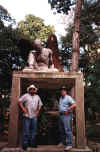 Caracas itself
is not dissimilar to other large cities. The traffic congestion, subway systems,
high-rise skyscrapers, and its share of richer and poorer neighborhoods is much
like any other. In fact it is significantly better off than most of its Latin
American cousins. As you venture into the interior however things began to
change. From Caracas International to points inland the rides start becoming
smaller and smaller. The first leg of our journey was on a two prop deHavilland
to Ciudad Bolivar, pretty much the only city in the interior of Venezuela that
can accommodate an aircraft any larger than a Cessna.
Caracas itself
is not dissimilar to other large cities. The traffic congestion, subway systems,
high-rise skyscrapers, and its share of richer and poorer neighborhoods is much
like any other. In fact it is significantly better off than most of its Latin
American cousins. As you venture into the interior however things began to
change. From Caracas International to points inland the rides start becoming
smaller and smaller. The first leg of our journey was on a two prop deHavilland
to Ciudad Bolivar, pretty much the only city in the interior of Venezuela that
can accommodate an aircraft any larger than a Cessna.  It was on this leg that we
were joined by my dad on our venture into the jungle. Here we stayed at the
Hotel Valentina, a well kept establishment with its own restaurant and bar, and
the last shower and flushing toilet that we would see for a while.
It was on this leg that we
were joined by my dad on our venture into the jungle. Here we stayed at the
Hotel Valentina, a well kept establishment with its own restaurant and bar, and
the last shower and flushing toilet that we would see for a while.
We were up early the next morning for a shuttle to the airport and our
subsequent ride in a six-seater Cessna deep into the interior of Venezuela. Both
here and in most of Latin America, Cessna’s are used as taxi's. No pre-flight
check, no kicking the tires here, just jump in, blast down the runway and go. Roughly half way into the hour and a half flight into the interior of Venezuela,
I commented to my video camera that it would have to serve as our black box. I
said so as the camera panned the dashboard and zoomed in on the fuel gauges. The
left one showed completely empty, and the right at 1/4. Dad rode shotgun for two
very good reasons. One, he is fluent in Spanish and two, he's a private pilot
himself. Upon cross-examination the pilot explained that the left gauge was
broken and that we shouldn't worry about that.
Roughly half way into the hour and a half flight into the interior of Venezuela,
I commented to my video camera that it would have to serve as our black box. I
said so as the camera panned the dashboard and zoomed in on the fuel gauges. The
left one showed completely empty, and the right at 1/4. Dad rode shotgun for two
very good reasons. One, he is fluent in Spanish and two, he's a private pilot
himself. Upon cross-examination the pilot explained that the left gauge was
broken and that we shouldn't worry about that.  It was at about this time that a
huge sheer cliff loomed up in front of us. We were cruising at about 5000 feet,
and this obstacle was easily 2000 feet above us. We banked right to go around
it. These huge table mountains, called "Tepuis" were trust thousands
of feet into the sky over a billion years ago in violent convolutions of the
planet.
It was at about this time that a
huge sheer cliff loomed up in front of us. We were cruising at about 5000 feet,
and this obstacle was easily 2000 feet above us. We banked right to go around
it. These huge table mountains, called "Tepuis" were trust thousands
of feet into the sky over a billion years ago in violent convolutions of the
planet.  Venezuela, in particular, is famous for these table mountains in its
Gran Sabana region in the southern part of the country. The largest of these
Tepuis is called the "Auyantepui", over which Angel falls flows in its
interior accessible via Devils Canyon from its north face. The Auyantepui has a
surface area on the top of over 750 square kilometers and has a completely
different weather system on the top from its base. Climbers viewing the sheer
faces of the Tepuis note how they would dwarf the likes of Yosemite's El
Capitan.
Venezuela, in particular, is famous for these table mountains in its
Gran Sabana region in the southern part of the country. The largest of these
Tepuis is called the "Auyantepui", over which Angel falls flows in its
interior accessible via Devils Canyon from its north face. The Auyantepui has a
surface area on the top of over 750 square kilometers and has a completely
different weather system on the top from its base. Climbers viewing the sheer
faces of the Tepuis note how they would dwarf the likes of Yosemite's El
Capitan.  While a tempting challenge, many climbers have died in the effort.
The problem is that the topography here is largely limestone, not the granite of El
Capitan. For this reason the pitons and other mountain climbing devices have a
extremely hard time getting a proper grip on the sheer face.
While a tempting challenge, many climbers have died in the effort.
The problem is that the topography here is largely limestone, not the granite of El
Capitan. For this reason the pitons and other mountain climbing devices have a
extremely hard time getting a proper grip on the sheer face.
Our chosen destination was the small Pemon tribe Indian village "Kavat"
on the far south side of the Auyantepui.  A
typical tourist excursion would initiate from the town of Canaima on the nearer
north side of the Auyantepui and run either for a single day round-trip, or perhaps one overnight stay at a base
camp in a two-day excursion into the falls and back. We elected to take the
"way less traveled by" with a five day boat trip through the jungle,
around the Auyantepui. After debarking, setting up camp in a small earthen hut,
A
typical tourist excursion would initiate from the town of Canaima on the nearer
north side of the Auyantepui and run either for a single day round-trip, or perhaps one overnight stay at a base
camp in a two-day excursion into the falls and back. We elected to take the
"way less traveled by" with a five day boat trip through the jungle,
around the Auyantepui. After debarking, setting up camp in a small earthen hut, and stringing up our hammocks, we met up with our tour guide for the excursion
who flew in separately with the provisions for the trip. "Gunther" was
an interesting bare footed German guy,
and stringing up our hammocks, we met up with our tour guide for the excursion
who flew in separately with the provisions for the trip. "Gunther" was
an interesting bare footed German guy, 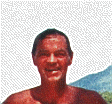 straight out of a "Raiders"
movie. His stated true vocation was as a gemologist, and had been in Venezuela
living with the Indians for the last five years looking for the famous
"rose quartz on the mother stone". When he found such a stone he was
going to buy a boat and travel the seven seas to the end of his days.
straight out of a "Raiders"
movie. His stated true vocation was as a gemologist, and had been in Venezuela
living with the Indians for the last five years looking for the famous
"rose quartz on the mother stone". When he found such a stone he was
going to buy a boat and travel the seven seas to the end of his days.  For now he
struck off barefoot and in shorts straight through the "razor blade
plants" with us in tow towards a hidden waterfall for us to take a swim.
This "baby" waterfall cascaded over the top of the mountain into a
pool below, and when Gunther advised us that any given moment a rain cloud could
pass over and flush us all
For now he
struck off barefoot and in shorts straight through the "razor blade
plants" with us in tow towards a hidden waterfall for us to take a swim.
This "baby" waterfall cascaded over the top of the mountain into a
pool below, and when Gunther advised us that any given moment a rain cloud could
pass over and flush us all  down the river we dubbed it the "Giant Flushing
Toilet". The water was clean and cool and we were at once refreshed and
looking forward to the journey ahead. At camp that night we indulged in the only
fresh meat meal of the journey of chicken smoked over an indigenous wood that
tasted marvelous. As from that point forward all provisions had to be packed
along, future meals would consist of spaghetti, goulash, and the like.
down the river we dubbed it the "Giant Flushing
Toilet". The water was clean and cool and we were at once refreshed and
looking forward to the journey ahead. At camp that night we indulged in the only
fresh meat meal of the journey of chicken smoked over an indigenous wood that
tasted marvelous. As from that point forward all provisions had to be packed
along, future meals would consist of spaghetti, goulash, and the like.  The
Embassy and customs folks had strictly forbidden us to bring "pistolas"
or any other firearms along, so unfortunately taking a wild boar was out of the
question. Gunther produced what was to become the ever present bottle of rum,
and dad responded with his flask of Jack Daniels. We then spent several hours
into the night telling grand lies about our past excursions and conquests and
making plans for the journey to come. This first night in the hammocks many of
us had a hard time going to sleep. This was the last night where that was to be
a problem, as from this point forward each day would be long and strenuous and
by the time we hit the bags we would be exhausted.
The
Embassy and customs folks had strictly forbidden us to bring "pistolas"
or any other firearms along, so unfortunately taking a wild boar was out of the
question. Gunther produced what was to become the ever present bottle of rum,
and dad responded with his flask of Jack Daniels. We then spent several hours
into the night telling grand lies about our past excursions and conquests and
making plans for the journey to come. This first night in the hammocks many of
us had a hard time going to sleep. This was the last night where that was to be
a problem, as from this point forward each day would be long and strenuous and
by the time we hit the bags we would be exhausted.
The next morning we were up at first light, bathed in the river, and packed
for the days adventure. The first leg of the journey was to be a cross-country
trek in a four-wheel drive to the town of Kamarat.  So far, then, what had begun
with a journey in a large commercial airliner had moved back in time through the
two prop deHavilland, a six seat single engine Cessna, and now we're in a
four-wheel drive. At the same time the facilities had regressed from flushing
toilets to a toilet in Kavat that did not flush, but had a bucket of water to
flush it with.
So far, then, what had begun
with a journey in a large commercial airliner had moved back in time through the
two prop deHavilland, a six seat single engine Cessna, and now we're in a
four-wheel drive. At the same time the facilities had regressed from flushing
toilets to a toilet in Kavat that did not flush, but had a bucket of water to
flush it with.
At Kamarat we picked up the river system on which we were to spend the next
week. The vessel was a roughly 20 ft. dugout with a 40 horsepower Yamaha on the
back.  Our Indian guides had the foresight to pack a spare outboard stuffed under
one of the benches, several spare propellers and a bucket full of shear pins. We
were to go through 3 props and all of the shear pins before this journey was
over. Due to our 8 man excursion being reduced to just the four of us, we still
had the full complement of assistance that had originally been planned. In
addition to Gunther, 5 Pemon Indians were to accompany us on our journey. This
crew was headed up by the pilot of the boat who ran the outboard from the rear.
He was accompanied by three other adult Indians and one child "Tommy Lee"
who came along for no other reason than for the treat of eating some Western food
and getting out of the village for little while.
Our Indian guides had the foresight to pack a spare outboard stuffed under
one of the benches, several spare propellers and a bucket full of shear pins. We
were to go through 3 props and all of the shear pins before this journey was
over. Due to our 8 man excursion being reduced to just the four of us, we still
had the full complement of assistance that had originally been planned. In
addition to Gunther, 5 Pemon Indians were to accompany us on our journey. This
crew was headed up by the pilot of the boat who ran the outboard from the rear.
He was accompanied by three other adult Indians and one child "Tommy Lee"
who came along for no other reason than for the treat of eating some Western food
and getting out of the village for little while.  This five man crew would pilot
the boat, drag it and our gear over some otherwise un-navigable rapids while we
walked around through the jungle, set up and tear down camp, cook and the meals,
and ensure that we had a safe journey into the interior of their world.
This five man crew would pilot
the boat, drag it and our gear over some otherwise un-navigable rapids while we
walked around through the jungle, set up and tear down camp, cook and the meals,
and ensure that we had a safe journey into the interior of their world. Gunther,
for his part, had been living with the Indians for the last five years and was
the well versed in the language, customs, and terrain, and always had some
interesting if a bit hard to follow Indian campfire stories.
Gunther,
for his part, had been living with the Indians for the last five years and was
the well versed in the language, customs, and terrain, and always had some
interesting if a bit hard to follow Indian campfire stories. 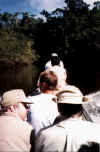 The next several
days were spent motoring down the river systems towards our final destination of
"Santo Angel", or Angel Falls. Angel Falls is not named due to its
proximity to the heavens, but after the American pilot, Jimmy Angel, who
"discovered" them upon crash landing his plane on the top of them in
1937 while on a gold hunting expedition.
The next several
days were spent motoring down the river systems towards our final destination of
"Santo Angel", or Angel Falls. Angel Falls is not named due to its
proximity to the heavens, but after the American pilot, Jimmy Angel, who
"discovered" them upon crash landing his plane on the top of them in
1937 while on a gold hunting expedition.
The Akanan River would lead to the Carrao, which in turn leads to the Churun
which, when followed upstream, leads into Devils Canyon and ultimately to the
base of the falls. Along the way we stopped and visited several Indian villages.
 The second night was spent at the Iwana Meru camp. Here, deep in the Venezuelan
jungle was not one but two mud hut churches, one Catholic and one Protestant.
The missionaries had been busy here. We were awoken promptly at 5:00 the next
morning by a cacophony of roosters crowing, bells ringing, and choruses singing.
Gunther explained that there was fierce competition between
the two churches for the loudest choir and these games began at 5:00am. Here we negotiated with some of the natives for a few souvenirs like blow guns
and bows and arrows and set off once again down the river. The night prior to
the final excursion into Devils Canyon was spent at a jungle camp on the river
bank. At this point our beloved slit trench at Iwana Meru was replaced with a
trowel and a hike off into the jungle.
The second night was spent at the Iwana Meru camp. Here, deep in the Venezuelan
jungle was not one but two mud hut churches, one Catholic and one Protestant.
The missionaries had been busy here. We were awoken promptly at 5:00 the next
morning by a cacophony of roosters crowing, bells ringing, and choruses singing.
Gunther explained that there was fierce competition between
the two churches for the loudest choir and these games began at 5:00am. Here we negotiated with some of the natives for a few souvenirs like blow guns
and bows and arrows and set off once again down the river. The night prior to
the final excursion into Devils Canyon was spent at a jungle camp on the river
bank. At this point our beloved slit trench at Iwana Meru was replaced with a
trowel and a hike off into the jungle.
That night dad and Gunther got to reminiscing about the wild and woolly days
in Venezuela in the early '60s. Dad recounted one story about those old
"Commies vs. capitalist" days where a particular Soviet Communist
Party recruiter had entrenched himself in the local college system as a
"perpetual student". In Embassy circles his nickname was "pepe de
oro" which translates as "(use your imagination) of gold" due to
his uncanny ability to seduce his fellow female students in his recruiting
efforts. Due to the back channel efforts of dad and his friends at the Embassy,
the academic requirements were tightened to the point that "pepe" was
forced by rule to graduate and move on from that fertile recruiting ground. Once
again Gunther had another colorful if convoluted Indian fable for us, Glenn
recounted some of his hell stories from the 'Nam, and Jaime and I soaked it all
in.
Angel Falls
The next morning we departed our base camp at daylight and began our journey
up the many rapids of the Churun river to the base camp below Angel Falls. 
 Here
we were reduced to hiking boots as we worked our way up the rocky slope through
the jungle for an hour and a half hike to the base.
Here
we were reduced to hiking boots as we worked our way up the rocky slope through
the jungle for an hour and a half hike to the base.
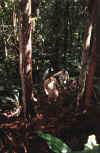 Upon reaching the base of
the falls the top of the mountain was completely enshrouded in its own weather
system.
Upon reaching the base of
the falls the top of the mountain was completely enshrouded in its own weather
system. 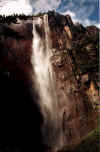
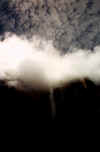 At 983 meters high - that's 16 times the height of Niagra Falls - the
sheer rock face seemed to disappear into the heavens. At this point while we
were taping the scene the clouds dissipated as if on cue to expose the top of
the giant Tepui. A short hike closer still to the base found us at a giant pool
with the water cascading in from above.
At 983 meters high - that's 16 times the height of Niagra Falls - the
sheer rock face seemed to disappear into the heavens. At this point while we
were taping the scene the clouds dissipated as if on cue to expose the top of
the giant Tepui. A short hike closer still to the base found us at a giant pool
with the water cascading in from above.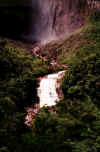 Several dozen yards beyond, the water
that had plummeted well over half a mile was shredded by its fall into a
terminal velocity mist.
Several dozen yards beyond, the water
that had plummeted well over half a mile was shredded by its fall into a
terminal velocity mist. 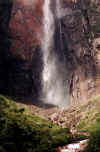 Here we stripped down and swam in the pool and under the
falling water until our guides advised us that we best pack it up in order to
make the trip back down river to our base camp before darkness fell. From this
view point we could survey the huge Devils Canyon below us and would surely have
thought we were standing on the top of the world as long as we avoided looking
at the 3000 foot cliff behind us.
Here we stripped down and swam in the pool and under the
falling water until our guides advised us that we best pack it up in order to
make the trip back down river to our base camp before darkness fell. From this
view point we could survey the huge Devils Canyon below us and would surely have
thought we were standing on the top of the world as long as we avoided looking
at the 3000 foot cliff behind us.  We all had the feeling that we'd gone back in
time thousands of years and were just now turning around to hike back to the
present.
We all had the feeling that we'd gone back in
time thousands of years and were just now turning around to hike back to the
present.
Re-evolution
It was then a three-hour hike and boat trip back the base camp for our final
night in the jungle and preparations for returning to civilization the following
day. That night Gunther’s campfire Indian fable depicted a hero that had
learned to live in harmony with his brothers the animals and plants around him.
The antagonist was a giant snake that was bent on changing the order of things
to its own benefit and liking. The Indians here live in a manner not dissimilar
to how they lived 10,000 years ago. They are largely disease free, use no swear
words, insult no one, can count only as high as two (more than that is
"many"), and live in harmony in an environment where days and
generations are virtually indistinguishable from each other.
 The next morning we began the descent into the present day, starting with the
boat ride to Canaima, followed by a Cessna ride to Ciudad Bolivar where an
overnight stay at the hotel Valentina was followed by the two prop deHavilland
to Caracas and a 747 back to the present century.
The next morning we began the descent into the present day, starting with the
boat ride to Canaima, followed by a Cessna ride to Ciudad Bolivar where an
overnight stay at the hotel Valentina was followed by the two prop deHavilland
to Caracas and a 747 back to the present century.
**Sigh**
Fair play and straight shooting,
Todd
Contacts:
Gunther Lausegger gunlaus@hotmail.com
Thomas deRoquette thomasroquette@hotmail.com
Todd Inman
todd_inman@hughes.net








 The Angel Falls Safari
The Angel Falls Safari























 straight out of a "Raiders"
movie. His stated true vocation was as a gemologist, and had been in Venezuela
living with the Indians for the last five years looking for the famous
"rose quartz on the mother stone". When he found such a stone he was
going to buy a boat and travel the seven seas to the end of his days.
straight out of a "Raiders"
movie. His stated true vocation was as a gemologist, and had been in Venezuela
living with the Indians for the last five years looking for the famous
"rose quartz on the mother stone". When he found such a stone he was
going to buy a boat and travel the seven seas to the end of his days. 

















